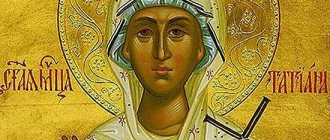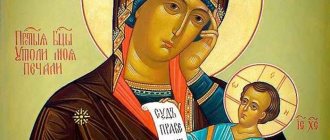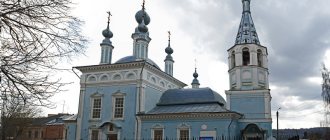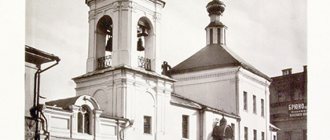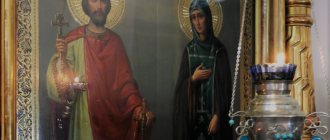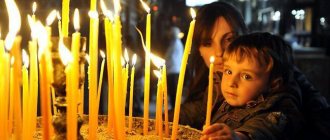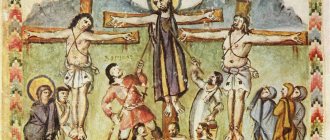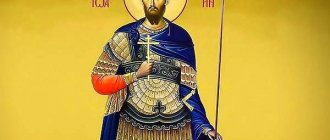Brief biography of the holy great martyr
The life of Eugene of Damascus dates back to the 1st century. The Sebastian and Melitian saints lived in the 3rd-4th century, under the emperor Diocletian, during the period of persecution and executions of Christians. People professing the Orthodox faith were arrested and tried. Christians hid in forests and caves, but did not renounce Christ. The emperor toughened the punishment for refusing to worship idols. Christians who were caught were sentenced to torture. If they continued to pray to one God, they were executed.
The life of the Sebastian Great Martyr is included in the description of the feat of the five-numbered Sebastian saints. It is known about him from hagiographic texts written in Armenian, Greek, and Latin. An ordered version was presented by Simeon Metaphrastus.
All three martyrs died at the hands of the pagans. The Martyrs of Sebaste and Melitene lived during the reign of one governor, Lysias, who sentenced them to execution.
Origin
The martyrs come from lands that belonged to the Eastern Roman Empire at the turn of the 3rd and 4th centuries. Eugene of Damascus lived on the territory of modern Syria. His parents are the famous martyrs Paul and Tatta of Damascus. There were three more sons in their family: Savinian, Maxim and Rufus. Before his death, Eugene of Sevastia lived in the city of Satalion, and was born in Aravrakina, in the state of First Armenia with its capital Sebastia. The martyr was in government or military service. Evgeniy Melitinsky also lived in ancient Roman Armenia. His exact place of birth is unknown. The martyr received his nickname from the name of the city of Melitina, in which he found his death.
Life and service to God
Nothing is known about the life of Eugene of Damascus. The biography of his family is not included in the modern Orthodox Monthly Book. The martyr of Melitino served in the detachment of Hieron, a faithful Christian. The squad consisted of 33 soldiers who professed Christianity.
Eugene of Sevastius secretly went to services with his friend and colleague Evstratiy. Both commanded military detachments, but Evgeniy was younger in rank and age. They knew that they faced death if exposed. Friends relied on the Will of God. In another version, Evstratiy was a high-ranking nobleman and the head of state notaries, and Eugene was his subordinate.
Death
Eugene of Damascus died along with his parents and brothers for their faith in Christ. Details about their death have not been preserved. Eugene of Sevastius suffered martyrdom together with his colleague Eustratius. Senior in rank, he spoke at the trial before the governor Lysias in defense of the Armenian presbyter Auxentius. Lysias did not expect betrayal from Eustratius and immediately ordered his arrest. Eugene followed his comrade and confessed to professing Christianity.
The friends were thrown into prison. The next morning they and other apostates were taken to public execution in Nikopol. The procession of prisoners passed through their hometown of Aravrakin. There the Christian Mardarius voluntarily revealed himself and joined the condemned. Several warriors also confessed to Christianity. Among them is Orestes, also a famous martyr.
All died after torture. Eugene’s tongue was cut out, his arms and legs were cut off, and then he was beheaded. On the day of remembrance of the Great Martyr of Sebaste, his brothers in faith Eustratius, Mardarius, Orestes and Auxentius are also remembered.
Evgeny Melitinsky died along with his squad. The governor Lysias called on Hieron to go to Cappadocia to destroy Christians. The commander refused and, together with the detachment, disappeared into a cave. Hiero's friend, Cyriacus, advised Lysias to recall the soldiers, and told Hiero that it was better to surrender. The military leader succumbed to the persuasion of Kiriak.
The detachment joined the recruits and moved to Melitin. At the general meeting, Lysias announced that it was time to make a sacrifice to the gods. 33 warriors of Hieron’s squad, including Eugene, refused to give glory to idols. The soldiers openly confessed their loyalty to Christ. The apostates were beaten with whips. They spent the night in prison. In the morning the soldiers were beheaded.
Angel Eugenia Woman's Day according to the church calendar
Eugenia of Rome is a saint with the female name Eugenia, whose feast day is celebrated on August 1, although in the Catholic Church her feast day is December 24. This saint lived an interesting life and came from a very noble Roman family.
She had a lot of suitors, but she did not give consent to any of them to marry and secretly took monastic vows in a monastery. She was accepted as a monk, and then the following story happened.
Not knowing who was really in front of her, a widow who was quite wealthy at that time fell in love with Evgenia and offered her a rich allowance. Evgenia rejected her proposal, for which the woman accused her of harassment. After this, Eugene was presented to the imperial court and she had to reveal who she really was, and her parents also found out about it.
However, the pagans killed Eugenia’s influential father secretly and he died in terrible martyrdom. They tried to kill Evgenia herself several times, but they did not succeed - she did not burn in fire or drown in water. Then she was beheaded. Today, the relics of Eugenia, like her icon, are considered healing.
Reverence
Days on which the martyrs are commemorated according to the old and new styles:
- December 13/26 - Sebastian;
- September 25/October 8 – Damascus;
- November 7/20 - Melitinsky.
On the day of the Sebaste Martyr, all five Armenian passion-bearers, natives of Satalion and Aravrakin, are commemorated. In November, the memory of all 33 Melitene warrior-martyrs of Hieron’s detachment is honored. Festive services in honor of the saints are held in churches consecrated in their honor. Believers and birthday people can honor the memory of the patrons of the house by reading a troparion of praise.
Talismans
Unlike old Russian times, these days a magnificent celebration of name days is a rarity. You can please someone who is patronized by Angel Eugene by congratulating them or giving them some nice little thing.
It is best to give any amulets and talismans that are suitable for the owners of this name:
- “lucky” colors are white, blue and green;
- ruby for men (a sign of energy and vitality);
- jade for women (symbol of intuition, calmness and kindness);
- gold (favorably affects career growth and influence);
- seahorse for men (a symbol of perseverance and determination in achieving your goals);
- hippopotamus for a woman (a sign of serenity, calm and tranquility);
- linden (symbol of sociability and cordiality);
- forget-me-not (a sign of strength of will and fidelity);
- hawthorn (promises well-being in family affairs);
- fir (will give you special patience and help you get rid of bad habits and various shortcomings).
Iconography
The collective image of Saint Eugene, according to the Armenian icon painting tradition, is a warrior in armor. Eugene of Sebastius is depicted separately or among the five martyrs, with Eustratius, Auxentius, Mardarius and Orestes. In Moscow, their first images appeared in the 18th century, after the head of Saint Auxentius was brought to the city.
A distinctive feature of the martyr Eugene, according to the descriptions of the icons, is a rounded beard. He is depicted with a red cloak behind his back, a spear or sword in his left hand and a cross in his right. There is an icon in which the martyr holds a shield with his left hand.
Saint Eugene is depicted at full height or waist-length, without weapons. In the Russian icon painting tradition, the martyr is dressed in green or blue clothes.
In half-length images, the red cloak is decorated with patterned edging. The martyr's face is slightly turned to the left or right. The cloak falls from the left or right shoulder, respectively. The saint is depicted with a cross in his right hand. Sometimes a paper scroll is depicted in the left hand. There is also a generalized image in which the martyr is dressed in brown clothes, a green cloak and holds a cross in his right hand.
Character traits
By calling their son or daughter Eugene/her, parents symbolically predict high mental qualities and well-developed intuition for the child. In addition to unique abilities, there are those that are characteristic only of a man or a woman.
Eugene Day:
- does not run away from work;
- strong in exact sciences;
- controls the situation well in multitasking mode, but is not always able to complete all tasks;
- distinguished by gentleness and generosity of character;
- He is good at recognizing falsehood, flattery and lies in people.
Eugenia Day:
- does not lose faith in himself even in difficult situations;
- like air, personal space is necessary, prone to individualism;
- can easily get carried away, but also easily lose interest in something;
- constantly strives for self-development, absorbs knowledge like a sponge;
- has good taste in art;
- knows a lot about how to keep a home;
- has well-developed communication skills;
- easily flammable, extremely emotional and therefore often goes into conflict.
Where can I find the icon
The most famous churches and temples in which the image of the saint is kept:
- in Moscow, in the Northern Tushino district, there is the chapel of Demetrius Donsoky. In its vestibule there is an icon of the martyr Eugene of Sebaste;
- in honor of the icon of St. Eugene, the church and monastery at the Novosibirsk Church of the Archangel Michael were consecrated;
- in the Belgorod region, in the village of Verigovka, a chapel and a bathhouse were built next to the holy Verigovsky spring of the martyr Eugene of Sebaste. An icon of the saint hangs in the chapel;
- in Voronezh, the walls of the Church of Saints Peter and Fevronia are decorated with frescoes with images of Saint Eugene and the Martyrs of Sebaste;
- The Spaso-Preobrazhensky Mirozhsky Monastery is located in Pskov. On one of the walls of the monastery there is a 12th century fresco depicting a martyr.
In Novosibirsk, at the Zaeltsovsky cemetery next to the Mochishchenskoe highway, there is a temple of the Holy Martyr Eugene. It was built with the permission of the bishop. The request for construction was submitted by a woman whose son named Evgeniy died. In the temple there is an icon of the patron saint.
To pray to St. Eugene, it is not necessary to look for an icon of a specific martyr. Before any image, you can ask for strengthening in faith and intercession.
Each church has a common icon of “All Saints”, revered in Orthodoxy. You can also pray to Saint Eugene in front of it. Personal icons are sold in online stores. A personalized image can be ordered from an icon painter. Images painted, embroidered yourself, or made to order must be consecrated in the church.
Persecution of Christians under Emperor Diocletian
In 302, Diocletian issued a decree to tighten the fight against Christianity. He ordered city rulers to destroy Christian churches, and to bring those who did not deviate from their faith to justice.
However, this law, barbaric in its cruelty, could not stop the zealots of the true faith. Having lost their temples, they did not stop gathering together to pray and hold divine services, only now all this happened in secret, and caves, remote groves and other places far from human eyes served as a refuge for them.
Seeing that his efforts to eradicate Christianity were not bearing fruit, Diocletian issued the following decree: now, if a Christian refused pagan sacrifices and did not renounce his faith, he was subject to the most cruel execution.
What do they ask for before the image?
The saint patronizes men named Eugene. Translated from Greek, the name means “noble.”
People turn to the martyr with everyday problems and questions of faith:
- own health and that of relatives;
- admonition for choosing the right solution;
- protection from slander and enemies;
- relief from poverty;
- courage in confronting despondency;
- strengthening in faith.
In front of the image of Eugene of Damascus, they ask for healing from drunkenness, kidney, and cardiovascular diseases. Martyr helps mentally ill people find peace. Clergymen turn to the image of the saint asking for support in spiritual service. Eugene of Sevastia patronizes the military. Relatives pray to the saint for the protection of the warrior during his service.
Meaning of the name
The names Eugene and Eugene came to us from Ancient Greece.
Literally translated, they mean “noble, selfless.” There is also a version according to which a person bearing this name is considered to be the one who will change the fate of his family. Analogues of the name Evgeniy/ya exist in many countries. So, in English-speaking regions (USA, England, Australia) people are called Gene or Eugene. In Belgium and France Eugenie or Eugene.
In Germany - Eugenia or Eugen. And in Spain, the names Eugenio and Eugenia are consonant with the Russian version.
What names are suitable for patronymics?
If you are thinking about what to name a girl if her father is Evgeniy, then pay attention to the fact that this patronymic will immediately determine her hard work, kindness and responsiveness. At the same time, she will never be a careerist, but will always remain a charming, interesting, pleasant girl. This patronymic goes well with the names Anna, Valentina, Vera, Ksenia, Christina, Lilia, Lyudmila, Natalya, Nina, Raisa, Yulia.
The boy can be called Alexander, Maxim, Artem, Mikhail, Ivan, Kirill, Andrey, Egor, Ilya, Alexey, Vladimir, Gleb, Lev, Stepan, Nikolai, Anton, Sergey. At the same time, they say that Eugene’s father’s patronymic will give his son solidity and innate leadership qualities, although the father himself does not have them.
